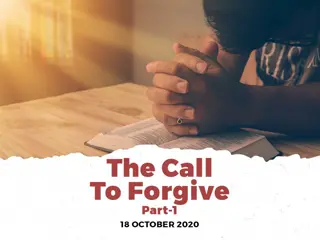The Role of Forgiveness in Healing and Organization Recovery from Toxic Leadership
Toxic leaders can leave lasting damage in organizations even after they are gone. Forgiveness plays a crucial role in healing individuals and the organization as a whole. It is an internal choice that allows for the transformation from passive hope to active hope. Creating conducive conditions for forgiveness, intervening with impactful acts, and shifting towards positive energy are essential principles for healing relationships, nurturing a healthy organization, and better serving clients. Qualitative interviews can help in understanding the organizational state, identifying readiness for change, and encouraging aspirations for a healthier future.
Download Presentation

Please find below an Image/Link to download the presentation.
The content on the website is provided AS IS for your information and personal use only. It may not be sold, licensed, or shared on other websites without obtaining consent from the author. Download presentation by click this link. If you encounter any issues during the download, it is possible that the publisher has removed the file from their server.
E N D
Presentation Transcript
THE ROLE OF FORGIVENESS IN HEALING AND ORGANIZATION FROM A TOXIC Dr. Kathleen E. Allen keallen1@charter.net www. Kathleenallen.net LEADER
Toxic leaders leave residual damage after they are fired! People who have aligned with the toxic leader also have damaged their relationships, but often aren t fired with the toxic leader Victims of the behavior of a toxic leader and people who violated their trust by wanting to please the leader or do their bidding also carry anger and emotions about them and the organization WHY IS FORGIVENESS NEEDED?
Forgiveness in an internal choice Move from hopeless, or passive hope to active hope is essential Individually and organizationally Sometimes the consultant has to hold the hope for a healthier organization before they are able to hold a vision for a healthy organization themselves If they can t forgive, they can t aspire to something more ASSUMPTIONS Aspirations and shared higher purpose are impacted by the deep need that is felt in the organization Healing relationships Healthy organization Serving clients better
Create conditions conducive to forgiveness Intervene with the smallest act that can achieve the highest impact Depends on connection and relationships DESIGN Depends on self-organization toward a healthy organization after the consultant is gone PRINCIPLES Requires a shift away from negative energy to positive energy Authenticity Reciprocity Shared higher purpose
Individual interviews (of all or people in key positions) Establishes relationship and trust with consultant Provides an opportunity for employee to tell their story Deep listening is part of the healing process THE PROCESS QUALITATIVE INTERVIEWS Invites them to imagine a healthy team / organization Reactivates their aspirations for something better PHASE Allows the consultant to discover what the current state of the organization is Helps the consultant recognize who is ready to change, who are self-protective, who might be resistant etc.
Identify themes and patterns CONTENT ANALYSIS Prepare the content themes so the interviewees can see what came up from individual s experiences this can normalize their experience Helps the whole group see what they aspire to collectively
RETREAT DESIGN HUMAN TIME LINE Line up by length of time in the organization Cluster by similar start dates Reflect on what the organization was like when they first arrived Share collective and individual story from their small group discussion Helps remember times when the organization was different Names the hurts and damage living with toxicity Builds empathy shared understanding of the cost of toxicity
RETREAT DESIGN SHARING THEMES AND OBSERVATIONS FROM INDIVIDUAL INTERVIEWS Can see their experience in the collective voice Allows for aspirations to be articulated How they want their relationships to be What a healthy team / organization looks like to them
People only support solutions that they help to create RETREAT DESIGN DEVELOPING SOLUTIONS People only pay attention to what matters to them here and now People and organizations grow and evolve with information In groups, have them come up with goals and actions that can they believe will help move the organization toward health
Staff Create Roll back Take Create Staff developed operating principles Work through issues directly (no talking behind people s back / spreading gossip) Create a common experience for all employees that reinforces our aspirational values Deliberately roll back rules and regulations that controlled others or are associated with toxic leader Take symbolic action that is reflective of who we want to be come (red coffee cups) Create reflective practice that lifts up default behavior SAMPLE SOLUTIONS
FOLLOW UP AND NEXT STEPS Coaching for key leaders Annual retreats Pattern of evolution (opposite, mix opposite with aspiration, to claim their choice Reinforce peer feedback and engagement Practice telling the truth to each other (because toxic environments make lying normal) Redesign performance reviews and job descriptions to support the shift toward a healthy organization Core vlaues
Initially hope moves from hopeless to passive hope Some shift to active hope Tentative behavior shifts start IT TAKES TIME Staff look to leaders to see if they are modeling the shift and supporting others to do so as well Increase supervisor and employees check ins Metrics that staff can see for themselves that let them know things are shifting Notice how common areas are supported (break room)
LAST THOUGHTS AND QUESTIONS Progress can be uneven in departments and teams depending on how exposed or protected they have been from the toxicity Not everyone stays as the organization gets healthier Victim mentality or can t forgive People who hold onto the toxic behavior Questions, thoughts, insights For a copy: go to www.kathleenallen.net sign up for my blog too!























